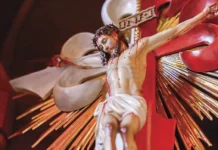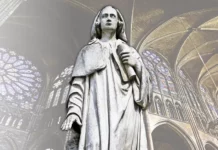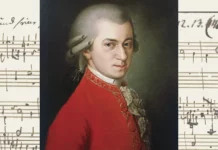Almost four centuries had passed and Christians did not dare to call Him God. Until, amidst struggles and persecution, the Cappadocian Fathers attested to the divinity of the Paraclete.
If the poet Luis de Camões called the Portuguese overseas adventures “daring Christian feats,”1 what words would he use in his writings to refer to the holy exploits that marked the fourth century from end to end?
Restricted to underground and clandestine worship in Rome, the persecuted Christians who lived at the turn of the third into the fourth century could hardly have imagined the rewards that Divine Providence had in store for them. However, in order to obtain them, Divine Providence imposed a condition: perseverance.
Those who remained steadfast in the true Faith would soon see enormous changes in the unfolding of events and would witness the greatest victories.
From liberty to the Council of Nicaea
In the year 311, a report spread throughout the Roman Empire that filled devout souls with hope: on the eve of his death, Emperor Galerius had left a document in favour of Christians.
They felt hope, it is true, but also great insecurity… How could one be sure that this was not a trap in order to bring Christians back to the arenas? It would be yet another two years before Constantine, through the Edict of Milan, granted Catholics true freedom of worship.
Certainly, it was a great victory for the Church. However, it was far from being an acknowledgement of Christianity as the official religion of the empire, and farther still from signifying the establishment of the Kingdom of Christ on earth.
Indeed, as soon as the Mystical Bride of Christ emerged into the sunlight, after sprouting like a seed in the catacombs beneath the earth, she was confronted with the tares of heresy, trying to suffocate her…
After a few years of freedom, many Christians had already allowed themselves to be enmeshed in error. Arianism was rampant among them, leading them to deny the divinity of Christ. To settle the matter, in 325 the Council of Nicaea was convened, whose Creed stated that the Son is consubstantial with the Father, and therefore God.
Yet even though the teaching of Arius was thus condemned by the great assembly, his followers continued to disrupt the Church’s life for centuries.
Friendships forged in God
During that time of open warfare, a boy of unusual qualities was growing up in Caesarea of Cappadocia. He was from a deeply Christian family, five other members of which are now venerated as Saints by the Church.
His name was Basil, and he began to study the rhetorical arts in his home town, and then went to Constantinople and Athens. When he returned to Caesarea, however, he gave up his wealth and career in order to dedicate himself entirely to God, first as a monk and then as a bishop.2
When he came into contact with the problems that the Church then faced, Basil set about developing arguments against the Arian heresy. With great wisdom, he sought to clarify theological language, putting into more precise terms doctrines which, often for lack of clear definition, had allowed room for ambiguity, controversy and apostasy.
One of his younger brothers, who had also been consecrated bishop, served as an important support in this struggle. He exercised his episcopal ministry in a metropolitan district of Caesarea, later becoming known as St. Gregory of Nyssa, the name of the territory of his diocese.
St. Basil also had friends who ascended to the honour of the altars. During his time in Athens, he strengthened his ties with another Gregory from the Nazianzen region, southwest of Cappadocia. Being of the same age and coming from aristocratic and Christian families, they soon formed a friendship that would unite them for life, forged not simply by an affinity of temperament, but above all by holiness, love of God and defence of true doctrine. In the same way, on account of the cause to which he had dedicated himself, Basil was esteemed by the great St. Athanasius.

Fighting for orthodoxy
In those historical circumstances, defending orthodoxy was essentially tantamount to rebutting heretics, which was usually done through speeches, letters and treatises.
St. Basil quickly engaged in the task of elucidating the truths proclaimed at Nicaea, opposing the Arian doctrines. Faithful to the teaching of St. Athanasius, he developed new arguments and refined the terms of the Trinitarian Theology defined by the Council,3 about which he declared in a letter:
“We cannot add anything to the Nicene Creed, not even the slightest thing, except the glorification of the Holy Spirit; and this is because our fathers mentioned this theme only in passing.”4
Besides Arianism, other heterodox doctrines, also promoted by false shepherds, were threatening to poison the flock of Christ. Among them were Semi-Arianism and Sabellianism, which spread subtler Christological errors.
The Paraclete is declared God

Faced with these new deviations, the paladins of the Faith were not to remain inactive. In 362, St. Athanasius convened a council in Alexandria, in connection with which St. Basil again insisted on a correct definition of theological terms.5 This precision of language desired by the great Doctor of the Church was not only a requirement of a doctrinal nature, but it was also the first step chosen by Providence to glorify the Third Person of the Blessed Trinity.
In this context, St. Basil wrote, in the year 375, his treatise On the Holy Spirit. In it, the divinity of the Paraclete is defended, but, as has been said, it was only an initial step… Although the author offers all the arguments that would allow this truth to be affirmed, he does not go so far as to affirm unequivocally the consubstantiality of the Holy Spirit with the Father.
St. Gregory of Nyssa would later say that, although St. Basil already believed in this doctrine, he supported it with deeds and not with words, because it was expedient that the consubstantiality of the Son be accepted before broaching that of the Holy Spirit.6
It was St. Gregory Nazianzen who, sharing the same ideals and, above all, the same faith as his friend Basil, one day decided to courageously proclaim before God, Angels and men that which was no longer possible to hide: “Until when will we hide the lamp under the bushel and deprive others of the full knowledge of the divinity [of the Holy Spirit]? The lamp should be placed atop the lampstand so that it may illuminate all the churches and every soul, no longer by metaphors or intellectual sketches, but by clear declaration.”7
Thus, in this sermon of St. Gregory given in the year 372, the Paraclete was categorically declared God.
The end of heresy?
One might expect that with such a great blow, the heretics would have been definitively defeated, but it was not so. The struggle continued and, with the passing of the years, new arguments were coined, obliging the Cappadocian Fathers – St. Basil, St. Gregory of Nyssa and St. Gregory Nazianzen – to write and preach to thoroughly refute each one of these fallacies.
Carrying further the arguments set forth in the stated in the treatise On the Holy Spirit, St. Basil continued the battle through sermons, letters, and the institutionalization of the liturgical cult.
St. Gregory Nazianzen stood out for his composition of forty-five theological discourses, most of them given between 379 and 381. Among these are the Five Theological Discourses on the Divinity of the Logos, in which he defends the dogma of the Church against the Eunomians and the Macedonians. Later, his works earned him the title of “the Theologian”.8
St. Gregory of Nyssa, for his part, drafted the four treatises Against Eunomius, an Arian heretic who attacked the faith of St. Basil. He also wrote against the Apollinarians and the Macedonian Pneumatomachi, clarifying various questions which resulted from the affirmation of the divinity of the Holy Spirit.
Final battles and conquests
A supporter of the Arians, Emperor Valens tried on numerous occasions to undermine the authority of St. Basil in the Cappadocia region. But in 378 this ruler died and shortly after, on January 1, 379, the immortal St. Basil ascended to Heaven at just fifty years of age.
It seemed that with Valens’ death there would be new conditions of peace, and so it was. He was replaced on the throne by the Catholic Theodosius, who in 380 recognized Christianity as the official religion of the empire.
Since even so the heresies did not cease, Theodosius convoked a new Council to be held in 381 in Constantinople, in which Gregory of Nyssa, then Bishop of Sebaste, intervened extensively in order to make official and finalize the truths which he and his brother had so heroically defended, and for so many years. The famous Johannes Quasten comments in this regard: “Undoubtedly the foundations for this great event in the history of Christianity had been laid by Basil.”9
A few years later, probably in 385, St Gregory of Nyssa died.
St. Gregory Nazianzen, with the support of Theodosius, was recognized as Bishop of Constantinople, an important Episcopal See which had been in Arian hands during the Empire of Valens. However, some time later, being the object of accusations by the hierarchy of Egypt and Macedonia, he preferred to resign and withdraw to his native land, where he died in 390.

A feat founded on the rock
To the great epopee of the Church in the fourth century, we could well apply the Gospel passage: “the rain fell, and the floods came, and the winds blew and beat upon that house, but it did not fall, because it had been founded on the rock” (Mt 7:25).
The house is the true Faith: the floods of calumny and false prophets came, the storms of persecution fell, the heresies blew and the emperors attacked; but it was built on piety and on the doctrine of great Saints, and therefore it was founded on the rock. Standing by them, there was nothing to fear, for the Holy Spirit was guiding them.
What heroism! What courage on the part of these blessed shepherds to put forth such daring doctrines for the time amidst a minefield of heresy! What “daring Christian feats”! Such exploits do not fit into verses, for they transcend the boundaries of human metrics. They are dictated by the Most High and no one can claim not to have heard them.
God has His time and moments. That is why He knew how to divinely allow the centuries to pass before finally revealing himself to mankind. Everything was done gradually and without haste. But what would become of our Faith if those called to proclaim the divinity of the Holy Spirit had kept silent out of a fear of the power and prestige of heresiarchs?
What punishment Divine Providence would have reserved for them! And what would have been the punishment for the faithful of that time if they had rejected the explanation of such an important truth of our Faith! Perhaps the history of subsequent centuries would have been very different. ◊
Notes
1 CAMÕES, Luís Vaz de. Os Lusíadas. Canto VII, 14.
2 Cf. MOLINÉ, Enrique. Los Padres de la Iglesia. 6.ed. Madrid: Palabra, 2014, p.253-254.
3 Cf. LAPORTE, Jean. Les Pères de l’Église. Les Pères grecs. Paris: Du Cerf, 2010, t.II, p.118.
4 ST. BASIL THE GREAT. Epistola 258, n.2: PG 35, 950.
5 Cf. QUASTEN, Johannes. Patrología. La edad de oro de la literatura patrística griega. 3.ed. Madrid: BAC, 1977, v.II, p.252.
6 Cf. MOLINÉ, op. cit., p.256.
7 ST. GREGORY NAZIANZEN. Oratio 12, n.6: PG 35, 850.
8 QUASTEN, op. cit., p.268.
9 Idem, p.227.







